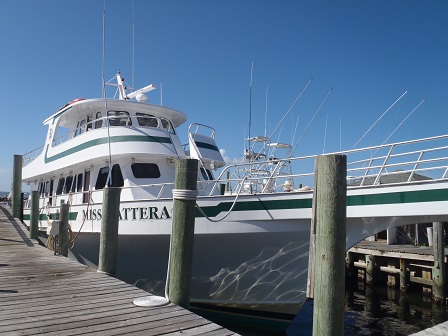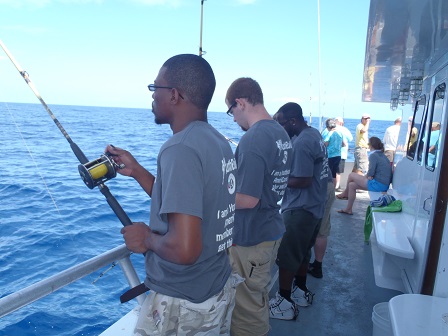By SARA MIRABILIO
“Two heads are better than one,” goes a popular saying. This is especially relevant to scientific research in the modern era. With the development of each new technology, it becomes increasingly difficult for scientists to conduct groundbreaking work on their own.
With that in mind, fisheries experts from not just two, but three Sea Grant programs — North Carolina, Virginia and New Jersey — collaborated to design a solution to safely release fishes that experience barotrauma.
These fishes have overinflated swim bladders, caused by a sudden change in barometric, or air, pressure. This happens when anglers quickly reel their catch to the surface.
As a fish is pulled up, barometric pressure is reduced and gas expands in its body. When the fish is released, it cannot expel the gas from its swim bladder and is unable to swim down. A fish floating at the surface is easy prey for predators.
If the barotrauma is severe enough, the fish could sustain life-threatening injuries, such as hemorrhaging tissue.
Together, the project team developed a variety of options that could return many fishes at a time to deeper water, as is needed in a head-boat fishing operation. See this article for the project overview.
From the onset, we knew that partnering with local head-boat captains was critical to project success. Each Sea Grant/industry partner team conducted testing off their own coast in an effort to generate location-specific information on best-handling practices, and on the usability and practicality of prototype descending devices.

In North Carolina, the barotrauma team took a trip aboard the “Miss Hatteras” with Capt. Spurgeon Stowe. Photo by Sara Hallas/NC Coastal Federation.
North Carolina’s trial took place off Cape Hatteras in May, aboard the Miss Hatteras head boat with Capt. Spurgeon Stowe at the helm.
Two N.C. Division of Marine Fisheries, or DMF, biologists joined the team on that trip. DMF had just finished their own research to determine the release mortality of species in the snapper grouper fishery related to recompression technique. We used their leftover tags on the fish we descended, or returned to the water. Returned tags will be reported through DMF’s tagging and recapture program.
There is one more tidbit of wisdom we have learned over many years on the job: Involving recreational anglers in developing best-handling practices for catch-and-release fishing further advances stewardship. Simply conducting education and outreach with recreational anglers would not foster the maximum level of use of any developed devices and adoption of other means of reducing barotraumas-related mortality of marine fishes.
So, we added more people to the partnership.
To recruit anglers for the research trip, North Carolina Sea Grant collaborated with the North Carolina Coastal Federation. We invited the nonprofit’s members and volunteers, each with varying value systems, personal characteristics, communication sources and social relationships. The participants could then influence the angling behaviors of others in their social networks.
The collaboration with the federation brought yet one more partnering opportunity: A connection with River City YouthBuild in Elizabeth City.
The organization provides economically disadvantaged youth, ages 16 to 24, with education and employment skills through construction projects. The work enables the young people to give back to their communities.

For some of the students from River City YouthBuild in Elizabeth City, this was their first time offshore. Photo by Sara Hallas/NC Coastal Federation.
The offshore research trip enabled 10 YouthBuild participants to learn about their local marine environment and ethical angling. However, the main purpose was to give them an outdoor fishing experience.
“It brought us back to the reality that the world is not flat, that it’s not full of dirt and dust and rocks,” says Jeffrey Smith, a YouthBuild chaperone. The students were pleased to be outdoors and to learn from the experienced anglers on the boat, he adds.
Fishing is a sport and an experience that can be shared and enjoyed by everyone. If you are anything like me, some of your fondest memories with your dad might revolve around fishing and being out on the water. But, these often are missed experiences for children from low-income families.
In addition to increased environmental awareness, outdoor recreation fosters social benefits that are important for youth, such as improved self-esteem, cardiovascular and muscular fitness, and social development.
In total, 35 anglers participated in the offshore research aboard the Miss Hatteras that day. In addition to the education and outreach presentation and materials shared, my North Carolina Sea Grant colleague Scott Baker and I were able to have in-depth discussions with 21 of the 35 anglers.
Some of our discoveries were noteworthy. This was the first offshore fishing trip for six people, with one of the YouthBuild anglers remarking it was his first time on a boat! Another 11 anglers go offshore fishing once or twice a year. The four most-seasoned anglers we spoke to go on two or more trips per year.
Only six anglers were familiar with barotrauma. All 21 anglers we spoke to said they would support a captain who used a descending device for marine fishes showing signs of barotrauma. They still would support use of a device even if it slowed fishing by 10 minutes or so.
Overall, the anglers were receptive of the research taking place and the use of prototype multi-fish descending devices.
Transformation has many faces: Extension specialist, head-boat captain, angler, nonprofit volunteer and low-income youth. The participants in this barotraumas project might not realize or acknowledge how they have learned through their work together. However, it is very likely that some of them have unknowingly caused change in others.
Regardless, all came together for a study that could transform the conservation of deep-sea fishes.
This article was published in the Holiday 2015 issue of Coastwatch.
For contact information and reprint requests, visit ncseagrant.ncsu.edu/coastwatch/contact/.
